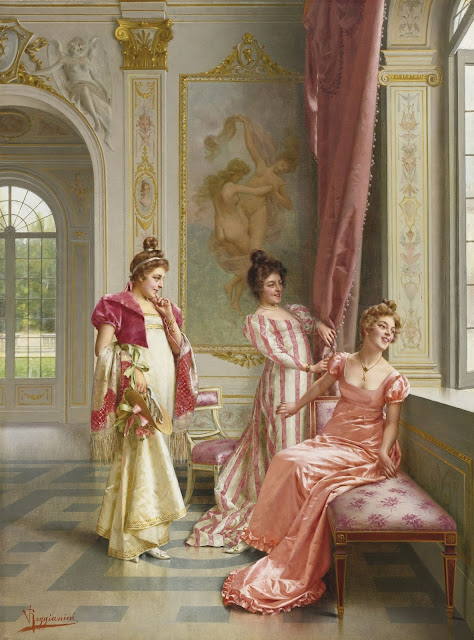Into the Rabbit-Hole: A Grotesque and Beautiful Look at the British Museum and Victorian-Era Taxidermy
The cover art for this story was a collaboration between me and rogue designer, incredibly patient mentor, and all-around badass Stephanie Hart. Which is to say that I sketched a pufferfish--and Stephanie Hart handled everything that required planning, polish, and general competence. Guess who wasted more time doing questionably-relevant source research?
When I first planned and wrote "The Affair at the British Museum," I fell down a weeks-long rabbit hole into 19th-century museums, natural history, and the gentle-yet-horrifying art of Victorian taxidermy.
The Amazing Architecture of the British Museum
My main source on the British Museum was a book kindly lent to me by writer, professor, and literary scholar Steve Mollmann. I first made friends with Steve in grad school, and he quickly became my go-to person to impose upon with annoying questions about Victorian science. He is not only the kind of guy to own an illustrated book detailing the history of a 19th century museum, but the kind of guy who would entrust me with such a book and also lived pretty close by.
Side-Note/Plug:
Steve's well-maintained, witty, and informative blog, Science's Less Accurate Grandmother, updates with intimidating regularity. His posts are a fun yet highly-organized ramble through the odd corners of Victoriana, sci-fi, and reviews of old and new books, comics, and other quirky pop culture. I can highly recommend it. In fact, I will.
In this time of global pandemic, rejection of science, and social media conspiracy theories, one post series in particular seems relevant. Check out Steve Mollmann's articles about scientist characters in Victorian literature, and what they tell us about the history of people's fear and distrust for science and medicine.
 |
| "Ew, no. Scientists are the worst boyfriends." |
Anyhow, figuring out the layout of the British Museum was an interesting journey. During its early days, Darwinism was widely accepted, but some people still though evolution threatened their religious beliefs. I know, crazy, right?
 |
| British Museum of Natural History, Central Hall (2013). Photo by DAVID ILIFF. License: CC BY-SA 3.0. |
This incredible building was typical of the attention and artistic detail the Victorians lavished on their architecture. Its ceilings and paneling were a literal catalog of zoology and botany. Thousands of terracotta tiles followed the museum-goer through the building with the kind of beautiful, lovingly-realistic illustrations you can still find in a 19th-century natural history book. Even the columns and arches were crawling with sculptures depicting the huge diversity of life forms British scientists were encountering as they explored the expanding reaches of their empire.
 |
| Column with terracotta monkey in the British Museum Central Hall. Photo by Iridescent. License: CC-BY-SA-4.0 |
The Victorians' Love-Affair with Taxidermy
Getting down the layout of the actual museum space took some work, but it was harder to get good information about what 19th-century museum visitors might actually see: The wet specimens and taxidermy that would have filled the museum with vivid displays of exotic creatures and, I imagine, a certain indescribable smell.
While the British Museum generally used the best preservation techniques available, not all taxidermy in the Victorian era was quite so professional. During my research for "The Affair at the British Museum," I stumbled across some less-than-scientific approaches to taxidermy.
We usually leave taxidermy to the professionals, and maybe your one creepy uncle who spends too much time alone. But for all their hang-ups, the Victorians had no problem going DIY with animal carcass decor. Arts-and-crafts books from the time period taught readers how to preserve and display dead animals, with pretty much the same casual tone as a weekend Pinterest project.
 |
| "Yep, just rub some arsenic all up in that organ cavity, ladies. LOL of course we're aware that arsenic is deadly, but it's whatevs. Do you or do you not want a living room that will make other Instagram moms jealous?" (Image from Art Recreations, Urbino and Day, 1871. Via Internet Archive.) |
And I don't even have room here to get started on all the other weird ways Victorians used taxidermy as art. If you want to plunge the depths of kitschy insanity, read up on Walter Potter. Love cute animals? Wish they would stay still while you dress them in adorable costumes and pose them into elaborate scenes? Look no further than Victorian sensation Walter Potter, whose art portfolio looks like a sweet old granny's opium-induced nightmares.
 |
| "Pfft, stupid dead kittens don't even know how to match their bridesmaid jewelry." (Walter Potter, detail from Kittens' Wedding, 1890s. From Walter Potter's Curious World of Taxidermy by Pat Morris, 2013. Image via book review in Vanity Fair by Bruce Handy, 2014.) |
Not to mention, it took some pretty pioneering 19th-century women to end the popular fashion for wearing taxidermy animals as hat trimmings.
 |
| "Am I smoking drugs because there is a dead squirrel on my head, or is it the other way around?" (Image via ByGonely.com) |
Actually, though, it isn't so bizarre if you consider the Victorians' comfort level with death. Women were expected to dismember dead animals in the kitchen, and prepare the corpses of dead loved-ones in their parlours. Though infant mortality was starting to decline as medicine improved, it was still common for Victorian women to witness the deaths of their own children due to diseases that didn't yet have vaccines, and of their friends during childbirth or from many other conditions that are no longer a death sentence.
Bottom line: "proper" Victorian ladies saw a lot of corpses. So is it really so shocking that they were fairly cavalier about plunking a dead pigeon on the table for a little light weekend crafting? If you want to know more about Victorian taxidermy, check out any of the sources linked throughout my post, and follow me down yet another entertaining rabbit hole.



Comments
Post a Comment